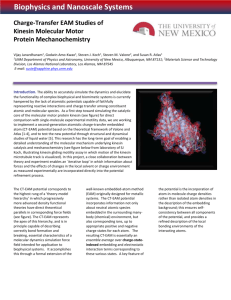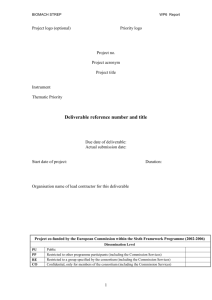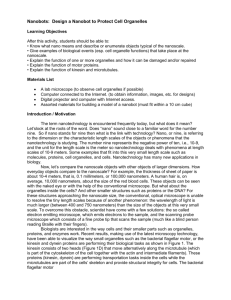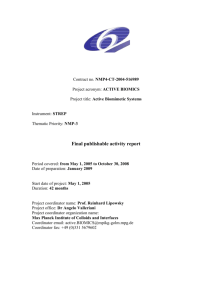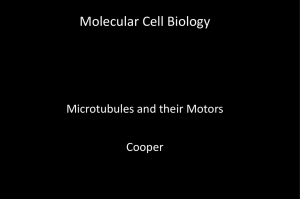Controlled Microtubules Transport on Patterned Non-fouling Surfaces
advertisement
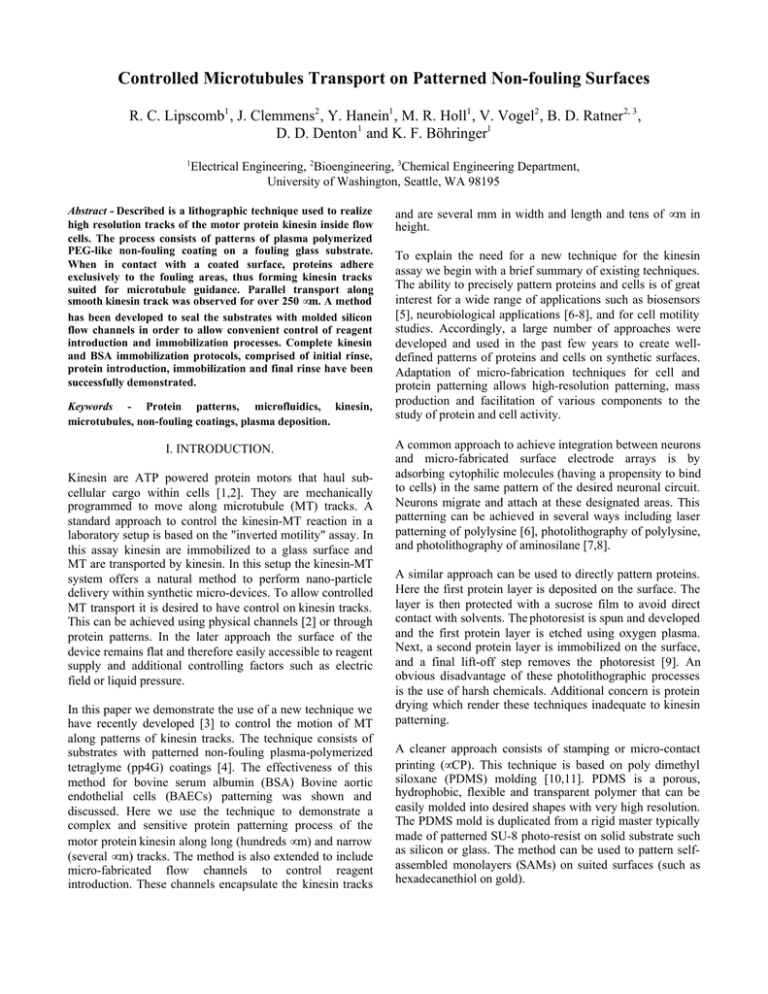
Controlled Microtubules Transport on Patterned Non-fouling Surfaces R. C. Lipscomb1 , J. Clemmens2 , Y. Hanein1 , M. R. Holl1 , V. Vogel2 , B. D. Ratner2, 3 , D. D. Denton1 and K. F. Böhringer1 1 Electrical Engineering, 2Bioengineering, 3Chemical Engineering Department, University of Washington, Seattle, WA 98195 Abstract - Described is a lithographic technique used to realize high resolution tracks of the motor protein kinesin inside flow cells. The process consists of patterns of plasma polymerized PEG-like non-fouling coating on a fouling glass substrate. When in contact with a coated surface, proteins adhere exclusively to the fouling areas, thus forming kinesin tracks suited for microtubule guidance. Parallel transport along smooth kinesin track was observed for over 250 µm. A method has been developed to seal the substrates with molded silicon flow channels in order to allow convenient control of reagent introduction and immobilization processes. Complete kinesin and BSA immobilization protocols, comprised of initial rinse, protein introduction, immobilization and final rinse have been successfully demonstrated. Keywords - Protein patterns, microfluidics, kinesin, microtubules, non-fouling coatings, plasma deposition. I. INTRODUCTION. Kinesin are ATP powered protein motors that haul subcellular cargo within cells [1,2]. They are mechanically programmed to move along microtubule (MT) tracks. A standard approach to control the kinesin-MT reaction in a laboratory setup is based on the "inverted motility" assay. In this assay kinesin are immobilized to a glass surface and MT are transported by kinesin. In this setup the kinesin-MT system offers a natural method to perform nano-particle delivery within synthetic micro-devices. To allow controlled MT transport it is desired to have control on kinesin tracks. This can be achieved using physical channels [2] or through protein patterns. In the later approach the surface of the device remains flat and therefore easily accessible to reagent supply and additional controlling factors such as electric field or liquid pressure. In this paper we demonstrate the use of a new technique we have recently developed [3] to control the motion of MT along patterns of kinesin tracks. The technique consists of substrates with patterned non-fouling plasma-polymerized tetraglyme (pp4G) coatings [4]. The effectiveness of this method for bovine serum albumin (BSA) Bovine aortic endothelial cells (BAECs) patterning was shown and discussed. Here we use the technique to demonstrate a complex and sensitive protein patterning process of the motor protein kinesin along long (hundreds µm) and narrow (several µm) tracks. The method is also extended to include micro-fabricated flow channels to control reagent introduction. These channels encapsulate the kinesin tracks and are several mm in width and length and tens of µm in height. To explain the need for a new technique for the kinesin assay we begin with a brief summary of existing techniques. The ability to precisely pattern proteins and cells is of great interest for a wide range of applications such as biosensors [5], neurobiological applications [6-8], and for cell motility studies. Accordingly, a large number of approaches were developed and used in the past few years to create welldefined patterns of proteins and cells on synthetic surfaces. Adaptation of micro-fabrication techniques for cell and protein patterning allows high-resolution patterning, mass production and facilitation of various components to the study of protein and cell activity. A common approach to achieve integration between neurons and micro-fabricated surface electrode arrays is by adsorbing cytophilic molecules (having a propensity to bind to cells) in the same pattern of the desired neuronal circuit. Neurons migrate and attach at these designated areas. This patterning can be achieved in several ways including laser patterning of polylysine [6], photolithography of polylysine, and photolithography of aminosilane [7,8]. A similar approach can be used to directly pattern proteins. Here the first protein layer is deposited on the surface. The layer is then protected with a sucrose film to avoid direct contact with solvents. The photoresist is spun and developed and the first protein layer is etched using oxygen plasma. Next, a second protein layer is immobilized on the surface, and a final lift-off step removes the photoresist [9]. An obvious disadvantage of these photolithographic processes is the use of harsh chemicals. Additional concern is protein drying which render these techniques inadequate to kinesin patterning. A cleaner approach consists of stamping or micro-contact printing (µCP). This technique is based on poly dimethyl siloxane (PDMS) molding [10,11]. PDMS is a porous, hydrophobic, flexible and transparent polymer that can be easily molded into desired shapes with very high resolution. The PDMS mold is duplicated from a rigid master typically made of patterned SU-8 photo-resist on solid substrate such as silicon or glass. The method can be used to pattern selfassembled monolayers (SAMs) on suited surfaces (such as hexadecanethiol on gold). Stamping can be used to pattern cells by pattering selfassembled monolayers of protein-adhesive alkanethiol surrounded by regions of non-adhesive alkanethiol. Direct stamping of protein is also possible [12] by modifying the stamp properties (originally hydrophobic and elastic) in order to allow uniform printing of protein layers. Microstamping techniques can also be used to create highresolution neuronal networks [13] by stamping polylysine to areas where cell attachment is desired. Using a special setup it was demonstrated that these networks could be aligned to predefined electrodes in order to achieve recording with aligned electrodes [14]. The techniques described above proved useful for many applications. However, they are useful mainly for robust systems. Sensitive proteins such as enzymes cannot be patterned by direct stamping techniques, primarily because their activity is severely affected by drying. To circumvent this difficulty three-dimensional PDMS molded channels are used. Proteins can be introduced onto surfaces in a liquid form [15,16]. Repeated processes or multiple channels allow patterning of several proteins or cells on a single substrate. Further flexibility can be achieved by a new approach we have recently developed to pattern proteins. The technique allows protein patterning in wet environment but does not restrict the patterning to the flow channel patterns. Rather, the protein pattern is determined by an independent patterning of the surface chemistry of the supporting substrate (Fig. 1). With these devices, reagent introduction is independent of protein patterns. For dynamic protein systems, such as the kinesin system, this technique allows few exciting new options such as: MT transport perpendicular to the kinesin tracks (discussed later), and the use of flow to affect the MT transport. The technique described here is based on patterns of nonfouling surfaces (pp4G, plasma-polymerized tetraglyme [2]) on a fouling surface such as silicon or glass. The nonfouling coatings are plasma polymerized and offer superb non-fouling characteristics, excellent adhesion and easy patterning using a simple lift-off step (Fig. 2). In this approach the immobilization process occurs spontaneously simply by the introduction of the proteins to the surface. The non-fouling coatings are effective enough to block protein attachment and a final rinse can remove the residues of nonattached proteins. Flow cell pp4G pattern Glass substrate Fig. 1. A schematic drawing of the protein immobilization device used in this work. Thee device consists of a glass slide with a patterned fouling coating. The coating determines the protein patterns. A flow cell seals the glass substrate and is used to control reagent introduction. The flow cell could be a simple thin glass slide supported with grease or specially prepared PDMS molds. This approach offer an obvious advantage over the techniques mentioned above when a complex and sensitive protein immobilization assays, such as kinesin motility assay, is required. Additional features of the technique presented here is its simplicity, the ability to easily integrate protein patterns with electrodes (Fig. 2b) and flow channels and separation between fabrication and experimenting process: Unlike the stamping technique, the proteins are introduced into the device only when the device is complete, thus drastically reducing complications related to handling and storage (samples can be stored for over 3 months). The use of this technique also allows flexibility in reagent composition and introduction. pp4G on SiO2 B. Protein preparation Exposed SiO2 pp4G on CrAu pp4G on SiO2 Fig. 2. (a) Standard lift-off process is used to define the pp4G patterns. The patterns are aligned to gold patterns already on the surface. The plasma deposition process is conformal and completely compatible with standard micro-machining processes. (b) An ESEM image of low resolution pp4G patterns aligned to CrAu rings on silicon dioxide substrate. Scale bar is 250 µm. To demonstrate the capabilities of our technique glass substrates with patterned non-fouling coatings pp4G were used to immobilize the motor protein kinesin to specific binding areas. Kinesin tracks are used to guide the motion of microtubules. Flow channel devices were built and successfully tested with kinesin BSA. II. METHODS A. Substrate fabrication Thin micro cover glasses (Fisher) were used as substrates for the pp4G coatings. To achieve pp4G patterning, primer followed by photoresist (1.5 µm, AZ 1512) was applied to the substrate, exposed and developed in order to define openings in the resist for the later pp4G lift-off. After resist patterning the substrates were introduced to the plasma chamber. Prior to the pp4G deposition, samples were exposed to five minutes oxygen plasma etch to remove organic residue from exposed surfaces. The plasma deposition details are discussed elsewhere [17]. After the plasma deposition, the wafers were rinsed in acetone (in ultrasonic bath) to remove the photo-resist (liftoff). Due to the conformal nature of the pp4G deposition the acetone lift off was performed in a sonic bath to guarantee high resolution of pp4G patterns. The sonic bath duration was increased until consistent resolution was obtained at 45 seconds. The microfabrication processes were performed at the Electrical Engineering micro-fabrication lab at the University of Washington. The pp4G deposition was done at the University of Washington Engineered Biomaterials (UWEB) labs. Kinesin and BSA experiments were performed at the University of Washington Nanotechnology User Facility. Kinesin: Melanogaster conventional kinesin gene construct with a histidine C-terminal tag and its purification is described elsewhere [18]. BSA: Bovine serum albumin (BSA) was labeled with fluorescent tags (Oregon Green, Molecular Probes). A protein concentration of 3.5 mg/mL in citrated phosphate buffer solution at pH 7.4 was diluted to 0.35 mg/mL with BRB80 buffer. The buffer for all experiments was BRB80 (80 mM Pipes, 2 mM MgCl 2, 1 mM EGTA, pH 6.85 with KOH). C. Motility assay The flow-cells were filled first with buffer, next with casein (0.5 mg/mL in BRB80). Next a conventional kinesin solution (4 µg/mL kinesin with 0.2 mg/mL casein and 1 mM ATP in BRB80) was introduced, and finally a motility solution [~3.2 µg/mL of tetramethylrhodamine labeled microtubules (1 to 10 µm in length) containing 1 mM ATP, and stabilized by 10 µM Taxol with oxygen scavenging additives (20 mM D-glucose, 20 µg/mL glucose oxidase, 8 µg/mL catalase, 0.2% 2-mercaptoethanol)]. Assays were performed at room temperature (22 ºC). Microtubules were visualized on the patterned surface by a Leica DM-IRBE fluorescent microscope using rhodamine filters. Topographic walls on the surfaces were simultaneously visualized by ambient light in transmission microscopy. For each region, sequential images of microtubules gliding along the surface were captured using an Orca2 cooledCCD camera ( Hamamatsu). (imaged area 64 x 80 µm) Microtubule positions were tracked with Metamorph image analysis software (Universal Imaging). D. Flow cells and microfluidics Two setups were used to realize flow cells for the experiment in this paper. The first is a simple setup which consists of patterned glass substrate enclosed by a thin cover slip. A thin gap between the two surfaces was ensured using a double stick tape. Reagents were introduced into the channel manually using a micro-pipette. In a second setup the patterned pp4G substrates were combined with molded PDMS microfluidic flow channels (Fig. 3). The channels were replicated from an SU-8 mold patterned on silicon substrates. Silicone tubing (VWR, Silastic) was diffused with the PDMS mold to generate a complete fluidic system. A miniature commercial peristaltic pump (INSTECH, p625), was used to slowly introduce the different reagents into the PDMS flow channel. Flow rates were maintained at 4 to 80 µL/min. Fig. 4. A merged image of fluorescence images of labeled kinesin and MTs. Results of low resolution kinesin patterning. The bright region is covered with kinesin while the dark areas are coated with pp4G thus remain clean from kinesin attachment. The rough edges of the kinesin track dramatically reduce the probability of the MT to follow their edges. To improve transport performances we use high resolution, down to 2 µm wide, kinesin tracks (Fig. 5a). These tracks were achieved with a high resolution Cr mask. As before, the MT are exclusively attached to the surface in the regions with kinesin (Fig. 5b). With high resolution patterning the MT guidance is significantly improved and several MT are observed to follow the kinesin track for distances as long as 250 µm. 3" Fig. 3. A PDMS channel on a glass slide patterned with pp4G. A miniature commercial peristaltic pump was used to slowly introduce the different reagents into the PDMS flow channel. pp4G III. RESULTS To study the performances of our method with kinesin and MT a motility assay was performed using a simple setup consisting of low resolution patterned pp4G (edge roughness of 10 µm) on glass enclosed with a cover slip. The chemicals are introduced manually into the flow channel in a sequential order: First a buffer solution is introduced, next a solution of casein protein is introduced and immobilized. The casein proteins serve as a support bed to the kinesin protein and prevent their denaturalization. Next, a labeled kinesin solution is introduced. After five minutes of incubation the channel is rinsed with buffer. Finally the labeled MT are introduced and their motility is studied with a fluorescence microscope. Typical results are shown in Fig. 4. The bright central region (originally exposed glass) is covered with kinesin, while the remaining area (pp4G coated) is darker, indicating the absence of kinesin in these regions. The thin bright lines on the kinesin patch are labeled MT. In regions with kinesin MT attach to the proteins and are transported along the surface. On coated regions, in the absence of kinesin, MT do not bind to the surface. MT are transported along the kinesin patch until they reach the edge and then are released back to the solution. Due to the roughness of the patch edges, MT that reach the edge are not capable of tracing the edge. 25 µm kinesins (a) microtubules (b) Fig. 5. (a) A pp4G pattern on glass with labeled kinesin immobilized on the surface. (b) A merged image of fluorescence imaging of kinesin and MT. The bright rod shapes correspond to MTs gliding on kinesin coated regions on the surface. On regions without kinesin there is no MT transport. MTs that are partially bound or not attached to the surface appear blurred. To understand the significance of the kinesin track edge, we show in Fig. 6 a trace of several MT paths (bright dashed curves). The paths were obtained by adding together six frames, 10 sec apart. It is clearly seen that the edges allow the MT to bounce back from the edge into the track. The smoothness here can be affected both by the edge resolution (compare Fig. 5 to Fig. 4) as well as by the coating profile. To guarantee well defined edges, careful attention was directed to the lithographical definition of the conformal pp4G coating. gaps between lines and move perpendicular to the channels. Such designs can serve as sorting elements To further improve our technique we use microfabricated PDMS molded flow channels. Their main added advantage is the ability to control to entire biological assay through the microfluidic system. This would allow: Automated experimentation, easy control on various variables such as reagent concentration, as well as the use of liquid pressure to control or monitor the kinesin behavior. Fig. 6. Traces of MT on kinesin tracks. The traces were obtained by adding six recorded frames. The traces show the wiggled nature of MT transport on kinesin track due to repeated reflections from the track edges. Narrow, smooth and sparse channels allow MT transport parallel to the channels. It is observed that MT guidance is mainly determined by the incident angle. This issue will be discussed in detail elsewhere [19]. Additional factor is the MT length: Long microtubules can bridge the gaps between lines and move perpendicular to the channels. Such designs can serve as sorting elements. Qualitative demonstration of both parallel and vertical transfer is presented in Fig. 7. To test these devices we used patterned pp4G samples sealed with a PDMS flow channels (see Fig. 3). Both kinesin and BSA assays were carried out. The kinesin protocol is as described above. For the BSA protocol we first rinsed the flow channel with buffer, next green labeled BSA was introduced and incubated for 5 minutes. A final rinse process removes the BSA residues. Reagents were introduced to the flow channel using a peristaltic pump. The pump was stopped prior to each reagent exchange. Patterning results of labeled BSA proteins are shown in Fig. 8. Similar results were obtained with kinesin immobilization assay. (a) 25 µm Fig. 8. BSA immobilization results. The entire process was carried out in a PDMS flow channel using a peristaltic pump to control reagent introduction. IV. DISCUSSION (b) Fig. 7. Openings in the pp4G coatings serve as binding sites for the kinesin proteins. (a) Narrow, smooth and sparse channels allow microtubules transport parallel to the channels. (b) Long microtubules can bridge the We have demonstrated the performances of pp4G patterns to define kinesin tracks. We have shown that these kinesin tracks can guide MT transport. Transport was successfully achieved parallel to long straight, smooth and narrow kinesin track. Perpendicular transport was obtained for MT longer than the gaps between the tracks. A limiting factor is the transport dependence on the incident angle. To circumvent this problem samples are currently designed to include an initial alignment and sorting modules. The design combines kinesin tracks with flow control to control the angle of the MT as they are initially introduced into the device. Due to the simplicity and the compatibility of the process with standard micro-machining processes, incorporation of additional elements in the device, such as electrodes, is straightforward and has been achieved by prior lithographic steps. The integration of these systems into micro-fluidic channels can provide a complete framework for integrated experimental systems. While MT transport in the devices presented here is solely determined by surface chemistry, additional factors such as electrical field and flow can be used and will be studied as additional tools to control MT guidance in flow channels. Both parallel and vertical MT transport will be explored for sorting. V. CONCLUSIONS To conclude, pp4G non-fouling coatings were patterned and integrated into flow channels to allow kinesin patterning and controlled manipulation of microtubules. Parallel transport was observed along 250 µm paths. Micro-fluidic elements were incorporated to simplify reagent control. The technique presented here offers a novel approach to immobilize proteins with micron scale resolution. The unique features of our methods are: Straightforward pattern to electrode alignment, straightforward pattern to flowchannel alignment, complete separation between fabrication step and biological experimentation, inert materials, complete compatibility with microfabrication processes, and high resolution. ACKNOWLEDGMENT The authors wish to thank Winston Ciridon, and Xuanhong Cheng of UWEB for valuable assistance with the plasma deposition system. This research was supported in part by David and Lucile Packard Foundation grant 2000-01763, NASA grant NAG58784 and the University of Washington Microscale Life Science Center, an NIH Center of Excellence in Genomics Science. Work in the UW MEMS lab by YH and KB was supported in part by DARPA Bio:Info:Micro grant MD A972-01-1-002, NSF CISE Postdoctoral Research Associateship EIA-0072744 to YH and by Agilent Technologies, Intel Corporation, Microsoft Research and Tanner Research Inc. JC would like to thank the Center for Nanotechnology at the Univ. of Washington for support through an IGERT scholarship. REFERENCES [1] R. D. Vale, R. A. Milligan, The way things move: looking under the hood of molecular motor proteins. Science, 288, 88-95 (2000). [2] H. Hess, V. Vogel, Molecular shuttles made from motor proteins: active transport in non-biological environments, Reviews in Molecular Biotechnology, 82, 67-85 (2001). [3] Y. Hanein et al, Micro-machining of non-fouling coatings for bioMEMS applications, Sensors and Actuators B 81, 49-54 (2001). [4] G. P. Lopez, B. D. Ratner, C. D. Tidwell, C. L. Haycox, R. J. Rapoza and T. A. Horbett, Glow discharge plasma deposition of tetraethylene glycol dimethyl ether for fouling-resistant biomaterial surfaces, J Biomed Mater Res, 26, 415, (1992). [5] P. M. St. John, R. C. Davis, N. C. Cady, J. Czajka, C. A. Batt, and H. G. Craighead, Diffraction-based cell detection using microcontact printed antibody grating, J Clin Chem, 70, 1108-1111 (1997). [6] J. M. Corey, B. C. Wheeler, and G, J. Brewer, Compliance of hippocampal neurons to patterned substrate networks, J. Neurosci.Res, 30, 300-307, (1991). [7] D. Kleinfeld, K.H. Kahler, and P.E. Hockberger, Controlled outgrowth of dissociated neurons on patterned substrates. J. Neurosci. 8, 4098-4120 (1988). [8] J. M. Corey, B. C. Wheeler, and G, J. Brewer, Selective Silane Removal: A Technique for micropatterning of neurons in Culture, Proceedings of IEEE-EMBC, 1731-1732, (1995). [9] C. Padeste, H. Sorribas, L. Tiefenauer, Photolithographic Generation of Protein Micropatterns, PSI annual scientific report, 2000. [10] J. C. McDonald, D. C. Duffy, J. R. Anderson, D. T. Chiu, H. K. Wu, O. J. A. Schueller, G. M. Whitesides Fabrication of microfluidic systems in poly(dimethylsiloxane) Electrophoresis, 21, 27-40 (2000). [11] Y. Xia, J. A. Rogers, K. E. Paul, and G. M. Whitesides, Unconventional methods for fabrication and patterning nanostructures', Chem. Rev. 99, 1823-1848, (1999). [12] C. D. James, R, Davis, L. Kam, H. Craighead, M. Issacson, J. M. Turner, W. Shain, Patterned Protein Layers on Solid Substrates by Thin Stamp Microcontact Printing, Langmuir, 14, 741-744 (1998). [13] D. W. Branch, J. M. Corey, J. A. Weyhenmeyer, GJ Brewer, B. C. Wheeler, Microstamp patterns of biomolecules for high-resolution neuronal networks Medical-&-Biological-Engineering-&-Computing. 36, 135-41 (1998). [14] C. D. James, R, Davis, M. Meyer, A. Turner, S. Turner, G. Withers, L. Kam, G. Banker, H. Craighead, M. Issacson, J. Turner, W. Shain, Aligned microcontact printing of micrometer-scale poly-L-Lysine structures for controlled growth of cultured neurons on planar microelectrode arrays, IEEE Transactions on Biomedical Engineering, 47, 17, (2000). [15] A. Folch, A. Ayon, O. Hurtado, M. A. Schmidt, M. Toner, Molding of deep polydimethylsiloxane microstructures for microfluidics and biological applications, Journal of biomechanical Engineering - Transactions of the ASME, 121, 28-34 (1999). [16] D. T. Chiu, N. L. Jeon, S. Huang, R. S. Kane, C. J. Wargo, I. S. Choi, D. E. Ingber, G. M. Whitesides Patterned deposition of cells and proteins onto surfaces by using three-dimensional microfluidic systems, Proceedings of the national academy of sciences of the united states of America, 97, 2408-2413 (2000). [17] Y. V. Pan, Y. Hanein, D. Leach-Scampavia, K. F. Böhringer, D. D. Denton, and B. D. Ratner, A Precision Technology for Controlling Protein Adsorption and Cell Adhesion in BioMEMS, Proc. IEEE Workshop on Micro Electro Mechanical Systems (MEMS) (2001). [18] D.L. Coy, W.O. Hancock, M. Wagenbach, J. Howard, Kinesin’s tail domain is an inhibitory regulator of the motor domain. Nat. Cell. Biol. 1, 288-292 (1999). [19] J. Clemmens, in preparation.

